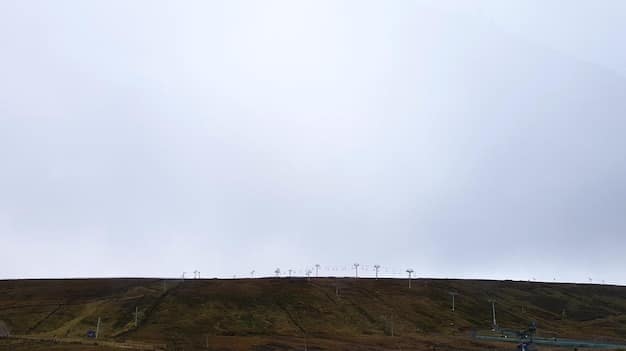Supreme Court Rulings: Impact on Clean Energy Sector Regulations

The latest Supreme Court rulings on environmental regulations can significantly influence the clean energy sector by potentially reshaping the regulatory landscape, impacting investment decisions, and affecting the pace of clean energy deployment in the US.
The clean energy sector is increasingly influenced by decisions made outside the realm of technology and innovation. One of the most significant factors impacting its trajectory is the evolving landscape of environmental regulations, particularly as shaped by recent Supreme Court rulings. Understanding what are the implications of the latest Supreme Court rulings on environmental regulations for the clean energy sector is crucial for investors, policymakers, and anyone interested in the future of sustainable energy.
Decoding the Supreme Court’s Environmental Decisions
Recent Supreme Court decisions have brought significant changes to how environmental regulations are interpreted and enforced. These decisions often involve complex legal interpretations that can have far-reaching consequences for various sectors, including clean energy.
Key Environmental Cases and Their Rulings
Several landmark cases have shaped the current environmental regulatory environment. Examining these cases provides insight into the Supreme Court’s evolving stance.
- Massachusetts v. EPA (2007): This case established that the EPA has the authority to regulate greenhouse gases.
- American Electric Power v. Connecticut (2011): The Supreme Court ruled that the EPA’s authority to regulate greenhouse gases under the Clean Air Act preempted federal common law nuisance claims.
- West Virginia v. EPA (2022): A more recent case that significantly limited the EPA’s authority to regulate greenhouse gas emissions from existing power plants.
Understanding the nuances of these rulings is critical to comprehending their collective impact on the clean energy sector.
The Supreme Court’s decisions often hinge on interpretations of existing environmental laws, such as the Clean Air Act and the Clean Water Act. These interpretations can either broaden or narrow the scope of regulatory authority, impacting industries and environmental protection efforts alike.

Impact on Clean Energy Investments and Innovation
The implications of Supreme Court rulings extend to the economic aspects of the clean energy sector. Regulatory uncertainty can affect investment decisions and the pace of innovation.
Regulatory Uncertainty and Investment
Uncertainty regarding environmental regulations can deter investors from committing capital to clean energy projects. Clear and stable regulations provide a more predictable investment environment.
For example, the West Virginia v. EPA ruling created uncertainty around the EPA’s ability to enact broad regulations on power plant emissions, which could affect investment in renewable energy sources as a replacement for fossil fuels.
Innovation and Technological Advancement
Environmental regulations can also spur innovation by creating market demand for cleaner technologies. However, overly restrictive or uncertain regulations can stifle innovation by increasing compliance costs and reducing investor confidence.
Government incentives and subsidies play a crucial role in promoting clean energy innovation. Tax credits, grants, and loan guarantees can help offset the costs of developing and deploying new technologies, especially in an uncertain regulatory environment.
Ultimately, the relationship between Supreme Court rulings, environmental regulations, and clean energy investment is complex. Legal decisions frame the context within which businesses operate, determining the feasibility and profitability of projects and incentivizing or disincentivizing innovation.
The Future of Environmental Regulation
The evolving landscape of environmental regulation, influenced by Supreme Court rulings, presents both challenges and opportunities for the clean energy sector.

Navigating a Changing Legal Landscape
Businesses in the clean energy sector must stay informed about legal developments and adapt their strategies accordingly. This involves understanding the potential implications of Supreme Court rulings and working to shape future regulations.
- Engaging with Policymakers: Participating in the regulatory process can help ensure that regulations are practical and effective.
- Seeking Legal Expertise: Consulting with environmental law experts can provide valuable insights into navigating the legal landscape.
- Diversifying Investments: Investing in a range of clean energy technologies can help mitigate the risks associated with regulatory uncertainty.
Actively engaging with policymakers and seeking legal expertise are critical for navigating this ever-changing landscape.
The impact of Supreme Court rulings will depend on how policymakers respond. Congress and the executive branch can enact new legislation or issue new regulations to clarify the scope of environmental protections.
The future of environmental regulation, and its impact on the clean energy sector, depends on the interplay between legal decisions, policy responses, and technological innovation. By understanding these dynamics, stakeholders can work together to create a sustainable and prosperous future.
Policy Implications for Clean Energy
Changes in environmental regulations spurred by Supreme Court verdicts have profound policy implications for the advancement and sustainability of clean energy initiatives.
Government Incentives and Subsidies
Federal and state governments often provide various forms of financial support to encourage the development and adoption of clean energy technologies. These incentives can take the form of tax credits, grants, and loans.
The Supreme Court’s stance on environmental regulations can affect the level and type of incentives available. For example, if the Court restricts the EPA’s ability to regulate emissions, policymakers may increase financial incentives for clean energy to achieve climate goals through market mechanisms.
Renewable Energy Standards
Many states have adopted renewable energy standards (RES) that require utilities to generate a certain percentage of their electricity from renewable sources. These standards can drive demand for clean energy and support the deployment of renewable energy technologies.
The effectiveness of RES can be influenced by Supreme Court decisions that impact the cost and competitiveness of renewable energy. If regulations become more lenient towards fossil fuels, policymakers may need to strengthen RES to maintain progress toward clean energy goals.
The Role of International Agreements
International agreements and commitments play a significant role in shaping domestic environmental policies and influencing the clean energy sector.
Global Climate Commitments
The Paris Agreement, for example, sets a global framework for reducing greenhouse gas emissions and mitigating climate change. While the United States has rejoined the Paris Agreement, the level of commitment and specific policies can still be influenced by domestic legal and political factors.
Supreme Court rulings can impact the ability of the United States to meet its international climate commitments. For example, if the Court limits the EPA’s authority to regulate emissions, it may be more challenging for the U.S. to achieve its emission reduction targets under the Paris Agreement.
Cross-Border Energy Trade
The clean energy sector is increasingly interconnected across borders, with countries trading renewable energy and collaborating on clean energy projects. International agreements can facilitate this trade and cooperation.
However, Supreme Court rulings that impact domestic environmental regulations can also affect international energy trade. For example, if the U.S. weakens its environmental standards, it may face pressure from other countries to align its policies with international norms.
State-Level Initiatives and the Clean Energy Sector
While federal regulations and Supreme Court decisions set the broader context, state-level initiatives also play a critical role in shaping the clean energy sector.
State Renewable Portfolio Standards
Many states have implemented Renewable Portfolio Standards (RPS), mandating that a certain percentage of electricity comes from renewable sources. These policies directly drive demand for clean energy.
RPS can vary significantly from state to state, reflecting different priorities and resources. For instance, California has a particularly ambitious RPS, while other states have more modest targets.
Regional Cooperation
States often collaborate on regional initiatives to promote clean energy, such as the Regional Greenhouse Gas Initiative (RGGI) in the Northeast. These initiatives allow states to share resources and expertise, and can be more effective than individual state actions.
State-level initiatives are crucial for driving the clean energy transition. They provide a testing ground for innovative policies and can help build momentum for federal action. By understanding the interplay between federal regulations, Supreme Court decisions, and state-level initiatives, stakeholders can more effectively navigate the complex landscape of clean energy policy.
| Key Aspect | Brief Description |
|---|---|
| ⚖️ Legal Impact | Supreme Court rulings shape environmental regulations, impacting the EPA’s authority and industry compliance. |
| 💰 Investment | Regulatory uncertainty affects investment decisions; stable regulations foster investor confidence in clean energy. |
| 💡 Innovation | Regulations drive clean tech innovation; incentives and clear standards boost it further. |
| 🌍 International | Global agreements like Paris influence domestic policies; rulings may impact U.S. commitments and energy trade. |
frequently asked questions
▼
Supreme Court decisions can either expand or restrict the EPA’s regulatory capabilities, influencing the agency’s power to enforce environmental protections and emission standards.
▼
Government incentives, such as tax credits and grants, are crucial; they lower the financial risk for businesses and individuals investing in clean energy technologies and projects.
▼
State regulations are often more specific and aggressive than federal ones, and they can accelerate clean energy adoption by mandating renewable portfolio standards and setting emission goals.
▼
While regulations can drive innovation by creating demand for cleaner technologies, overly strict or uncertain rules could potentially increase compliance costs and discourage investment in new solutions.
▼
Cooperation helps countries share technologies, coordinate policies, meet international commitments, and foster a global transition to more sustainable energy solutions addressing climate change.
Conclusion
The intersection of Supreme Court rulings and environmental regulations forms a pivotal influence on the clean energy sector. Understanding these influences is critical for navigating the complexities and capitalizing on the opportunities within the evolving clean energy landscape.





